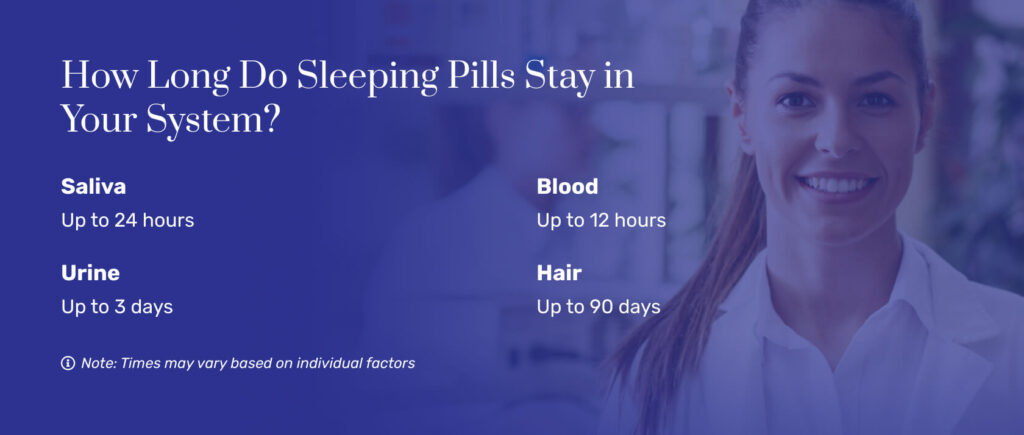If you are discontinuing the use of sleeping pills, remember that they can still be detected in your system for multiple days and even weeks after your last consumption. The exact detection time will depend on the type of test used.
Quick Facts About Sleeping Pill Half-Life
Key Facts
- Sleeping pill half-life varies greatly. For example, some sleeping pills have a short half-life, such as Ambien with its half-life of two to three hours. Others have a long half-life, such as Valium, which has a half-life of approximately 48 hours.
- Ambien requires approximately 1.5 hours to reach its peak concentration in the bloodstream. The time taken for this concentration to reduce to half, or the half-life, is approximately 2.5 hours in a typical adult male.
- While Ambien has a half-life of approximately two to three hours, it is potentially detectable for weeks via certain tests.
- A drug requires approximately five half-lives to be completely removed from the body, so sleeping pills like Ambien remain in the bloodstream for around 12 to 13 hours in a normal adult male.

How Long Are Sleeping Pills Detectable on Drug Tests?
Are you or someone you know struggling with addiction?
I may have a problem I am concerned for a loved oneThe time frame during which sleeping pills will show on drug tests depends on the type of drug test used.
- Urine test: Sleeping pills are detectable on urine drug tests for up to three days following the most recent use. Results are most reliable within 24 to 48 hours of use.
- Saliva test: The active ingredient in Ambien, zolpidem, can be detected in the saliva within one hour following consumption. It is detectable for approximately 24 hours after last use.
- Blood test: Sleeping pills are cleared from the bloodstream relatively quickly in comparison with other areas of the body. For example, Ambien is detectable via blood testing for about 12 hours after last use.
- Hair test: Traces of sleeping pill ingredients like zolpidem can be detected in hair for up to 90 days after last use.
Standard drug tests don’t test for sleeping pill use, but specialized tests can be used to detect use. Urine drug tests are most commonly used.
This chart breaks down how long you can expect sleeping pills to be detected on various types of drug tests:
| Test Type | Time Taken to Exit |
| Urine | Up to 3 days |
| Hair | Up to 90 days |
| Saliva | Up to 24 hours |
| Blood | Up to 12 hours |
Factors That Influence How Long Sleeping Pills Stay in the Body
Numerous factors can affect how long sleeping pills remain within your system, including these:
- Height: In general, taller people have greater mass, so sleeping pill ingredients will remain in the body for longer periods of time.
- Weight: As with height, more weight generally means more mass. This means sleeping pills will remain in one’s system for a longer period of time.
- Age and genetics: Familial history and genetic factors influencing physical health, such as organ functioning, can affect the length of time sleeping pill ingredients remain in one’s system. Metabolism and organ function also progressively decline with age and increase the length of time needed to clear sleeping pills from the body. Zolpidem clearance is also lower in women than men, on average.
- Dosage: Higher doses of sleeping pills require more time to be eliminated from the body than lower doses.
- Frequency of use: Consuming sleeping pills for longer periods of time and more frequently will leave traces of these medications in the body for longer periods of time.
- Consumption of other medications: The use of some medications can influence the amount of time sleeping pills remain in the body. For example, consuming St. John’s Wort may decrease the amount of time needed to eliminate sleeping pills from the body.
Food can influence how quickly sleeping pills take effect, but not the duration of time needed for them to be eliminated from the body. These factors highlight why detection windows vary so much between individuals. For those who’ve developed tolerance or dependence, an assessment at an Indiana drug detox center can help determine safe tapering needs and medical monitoring timelines.
How Do Sleeping Pills Affect the Body?
Sleeping pills affect the body by activating the neurotransmitter gamma-aminobutyric acid (GABA), which is a chemical messenger that regulates communication between brain cells. Activating this neurotransmitter blocks certain signals sent to the brain and reduces central nervous system activity, creating a sedative effect that allows consumers to fall and stay asleep while the drug remains in the system.
Signs of Sleeping Pill Abuse
Many sleeping pills are approved by the Food and Drug Administration (FDA) for the treatment of sleep disorders like insomnia. However, they can create tolerance and dependence, leading to the potential for abuse and addiction.
The following may be indications of sleeping pill abuse:
- Memory problems
- Slurred speech
- Reduced coordination
- Lack of balance
- Difficulty concentrating or maintaining conversation
- Unusual level of elation
The clearest indication of sleeping pill abuse is using the pills outside the bounds of a prescription. If someone is using pills that aren’t prescribed to them, using them more frequently or in higher doses than prescribed, or combining their use with other substances like alcohol, this is sleeping pill abuse. Reestablishing healthy rest patterns often begins in a supportive environment like a Massachusetts addiction treatment center, where treatment combines medical care with restorative therapies.
- Clinical Pharmacology in Sleep Medicine. (November 2012). ISRN Pharmacology.
- New Drugs for Insomnia: Comparative Tolerability of Zopiclone, Zolpidem and Zaleplon. (2003). Drug Safety.
- Pharmacotherapy of Insomnia: Focus on Zolpidem Extended Release. (April 2009). Clinical Medicine Insights: Therapeutics.
- GABA Mechanisms and Sleep. (2002). Neuroscience.
- Diazepam. (September 2022). StatPearls.
- A Case of Suicide Attempt With Zolpidem - Will Zolpidem Show Up on Standard Urine Toxicology Screening? (May 2014). EXCLI Journal.
- The GABAA Receptor Modulator Zolpidem Augments Hippocampal-Prefrontal Coupling During Non-REM Sleep. (June 2022). Neuropsychopharmacology.















